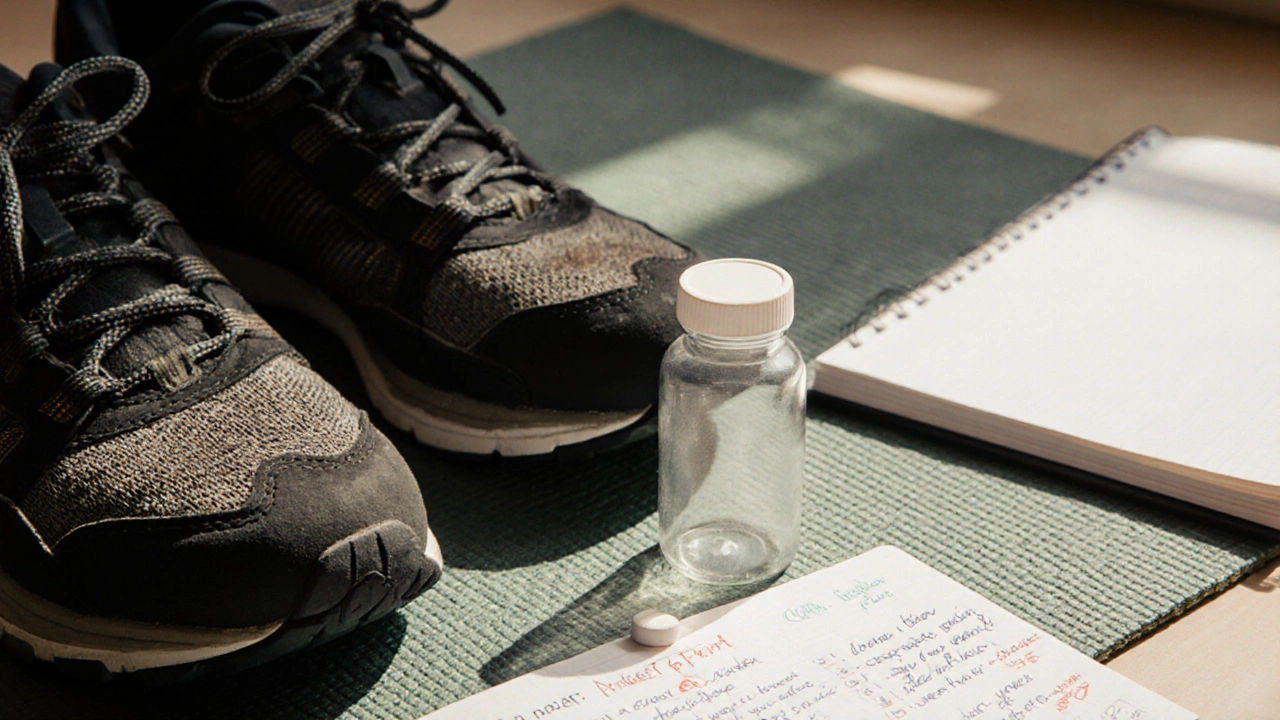 Nov, 16 2025
Nov, 16 2025
Acetaminophen Safety Calculator
Is Your Acetaminophen Use Safe?
This calculator helps you determine if your acetaminophen intake is within safe limits for long-term use. Based on guidelines from the British Journal of Clinical Pharmacology (2023).
Safe Usage
Your acetaminophen intake is within safe limits for long-term use.
When you’re living with chronic pain, finding a painkiller that works without wrecking your body is the real goal. It’s not about quick fixes-it’s about staying functional, avoiding hospital visits, and not becoming dependent on something that could hurt you more than the pain itself. Millions of people take painkillers every day, but not all of them are built to last. Some wear down your stomach. Others quietly damage your liver. A few? They can hook you before you even realize it.
There’s No Magic Pill-But There Are Safer Options
Let’s cut through the noise: there’s no single painkiller that’s perfectly safe for everyone over years of use. But some options are far safer than others, especially when used correctly and under medical supervision. The key isn’t just choosing a drug-it’s understanding how your body reacts to it, what alternatives exist, and how to layer treatments so you’re not relying on pills alone.
For most people with chronic pain, acetaminophen (also known as paracetamol) is the first-line choice for long-term use. It’s not perfect, but compared to other common painkillers, it has the best safety profile when taken within limits. A 2023 review in the British Journal of Clinical Pharmacology found that at doses of 3,000 mg per day or less, acetaminophen carries minimal risk of kidney or heart damage in healthy adults. That’s a big deal, because most other painkillers-like NSAIDs-carry clear warnings for long-term use.
Why NSAIDs Like Ibuprofen and Naproxen Are Risky Over Time
Nonsteroidal anti-inflammatory drugs (NSAIDs) like ibuprofen, naproxen, and diclofenac are everywhere. You can buy them over the counter. They work fast. But they’re not designed for daily, year-after-year use.
Here’s what happens when you take them long-term:
- Stomach ulcers: NSAIDs block protective enzymes in your gut lining. After 6-12 months of regular use, up to 30% of users develop ulcers-often without warning symptoms.
- Kidney strain: These drugs reduce blood flow to the kidneys. For people over 60 or with high blood pressure, this can lead to chronic kidney disease.
- Heart risks: A 2024 study in The Lancet showed that daily naproxen use for more than two years raised the risk of heart attack by 24% in people with existing cardiovascular conditions.
Even "low-dose" daily ibuprofen-say, 400 mg twice a day-isn’t safe for years. If you’ve been taking it for your arthritis or back pain, you’re probably doing more harm than good.
Acetaminophen: The Quiet Winner
Acetaminophen doesn’t reduce inflammation like NSAIDs do. That means it won’t help with swelling from a flare-up. But for dull, persistent pain-like osteoarthritis, fibromyalgia, or chronic back pain-it’s often enough.
Its biggest advantage? It doesn’t touch your stomach lining, kidneys, or heart. The only real danger is liver damage-and that only happens if you take too much.
Here’s what you need to know:
- Maximum daily dose: 3,000 mg for most adults (some guidelines say 4,000 mg, but 3,000 mg is safer for long-term use).
- Watch hidden sources: Cold medicines, sleep aids, and combo painkillers often contain acetaminophen. Taking two products together can push you over the limit.
- Alcohol? Don’t mix. Even one drink a day while taking acetaminophen increases liver risk.
People with liver disease should avoid it entirely. But if your liver is healthy and you stick to the dose, acetaminophen is the most reliable long-term option we have.
What About Opioids? The Trap Many Don’t See Coming
Opioids like oxycodone, tramadol, and codeine are powerful. They work. But they’re not safe for chronic pain. The CDC stopped recommending them for long-term non-cancer pain back in 2016-and the evidence has only gotten stronger since.
Here’s the truth:
- Tolerance builds fast. What worked at 5 mg today might need 10 mg in six months.
- Dependence is real. Withdrawal can be brutal-sweating, nausea, anxiety, insomnia.
- Overdose risk doesn’t go away. Even people who take their pills "as prescribed" have died from accidental overdose, especially when combined with sleep aids or alcohol.
Studies show that after one year of opioid use for chronic pain, less than 10% of patients report meaningful improvement in function. Most just end up taking more pills, with worse side effects.
Non-Pill Solutions Are the Real Game-Changer
The safest painkiller isn’t a pill at all. It’s movement. It’s sleep. It’s stress management.
Physical therapy isn’t a backup plan-it’s frontline treatment. A 2025 meta-analysis of 42 trials found that structured exercise programs (like walking, swimming, or strength training) reduced chronic pain by 40-60% over six months. That’s better than most painkillers.
Other proven non-drug tools:
- Heat therapy: For muscle pain, a heating pad for 20 minutes twice a day reduces stiffness better than ibuprofen.
- Cognitive behavioral therapy (CBT): Helps rewire how your brain processes pain signals. Works as well as opioids for some people-with zero side effects.
- TENS units: Small devices that send gentle electrical pulses to nerves. FDA-approved for chronic back and knee pain.
- Mindfulness and meditation: Reduces pain perception by 30% in long-term users, according to Johns Hopkins research.
These don’t replace medication-they reduce how much you need.
What About Topical Pain Relievers?
Creams, gels, and patches can be a smart middle ground. They deliver pain relief right where you need it, with almost no systemic side effects.
Topical NSAIDs like diclofenac gel (Voltaren) are approved for osteoarthritis in knees and hands. Studies show they work nearly as well as oral NSAIDs-but with 90% less drug entering your bloodstream. That means no stomach upset, no kidney risk.
Capsaicin cream (from chili peppers) is another option. It depletes substance P, a chemical that sends pain signals. It stings at first, but after a week, many users report less burning and more relief.

Who Should Avoid Acetaminophen?
Not everyone can use it safely:
- People with severe liver disease (cirrhosis, hepatitis)
- Those who drink alcohol daily
- People taking certain antiseizure or TB medications (like isoniazid)
- Anyone with a history of acetaminophen overdose
If you fall into one of these groups, talk to your doctor. There are alternatives-like low-dose antidepressants (amitriptyline), anticonvulsants (gabapentin), or even medical cannabis in places where it’s legal.
The Bottom Line: A Smart Plan Beats a Single Pill
If you’re taking painkillers every day for chronic pain, you need a plan-not just a prescription.
Here’s what a safe, long-term strategy looks like:
- Start with acetaminophen at 3,000 mg/day or less.
- Add topical treatments like diclofenac gel for localized pain.
- Build a movement routine: 30 minutes of low-impact activity five days a week.
- Try CBT or mindfulness if stress makes your pain worse.
- Review your meds every six months with your doctor. Ask: "Is this still helping?" and "What’s the plan if it stops working?"
Never assume a painkiller is "safe" just because it’s available without a prescription. The real safety comes from using the right tool for the right job-and knowing when to stop relying on pills altogether.
Is acetaminophen really safe for long-term use?
Yes, when used correctly. For healthy adults, taking up to 3,000 mg of acetaminophen per day for years carries minimal risk to the liver, stomach, kidneys, or heart-unlike NSAIDs or opioids. The key is avoiding alcohol, checking labels for hidden acetaminophen in other meds, and never exceeding the daily limit.
Can I take ibuprofen every day for chronic pain?
No. Daily ibuprofen use for more than a few months increases your risk of stomach ulcers, kidney damage, and heart problems. Even "low-dose" daily use isn’t safe long-term. If you’ve been taking it every day, talk to your doctor about switching to acetaminophen or non-drug therapies.
Are natural remedies like turmeric or CBD safe for long-term pain?
Turmeric (curcumin) may help reduce inflammation, but evidence is mixed and dosing isn’t standardized. CBD shows promise for nerve pain, but many products are unregulated and may contain contaminants. Neither replaces proven treatments, but they can be used alongside acetaminophen or physical therapy under medical guidance.
What’s the best painkiller for arthritis?
For osteoarthritis, topical diclofenac gel is often the best first choice-it works locally with almost no side effects. If you need something systemic, acetaminophen is safer than oral NSAIDs. Physical therapy and weight management are just as important as any pill.
Can I become addicted to acetaminophen?
No, acetaminophen is not addictive. It doesn’t affect the brain’s reward system like opioids or even some NSAIDs can. However, people can develop a psychological reliance on it if they’ve been using it for years without other pain management tools. That’s why combining it with movement and therapy is so important.
How do I know if my painkiller is doing more harm than good?
Ask yourself: Are you taking more than you were a year ago? Do you feel worse when you skip a dose? Have you noticed stomach pain, dark urine, swelling in your ankles, or fatigue? These are red flags. Schedule a review with your doctor-don’t wait until something breaks.
Next Steps: What to Do Today
If you’re on daily painkillers:
- Check the label of every medication you take. How much acetaminophen is in each? Add it up.
- Set a calendar reminder to talk to your doctor in 30 days. Bring a list of all your meds and your pain diary.
- Try one non-drug method this week: walk 20 minutes, use a heating pad, or try a free mindfulness app.
Chronic pain doesn’t have to mean lifelong pills. The safest approach isn’t about finding the perfect drug-it’s about building a life where you don’t need to rely on them.
